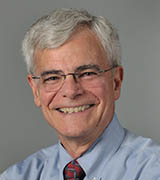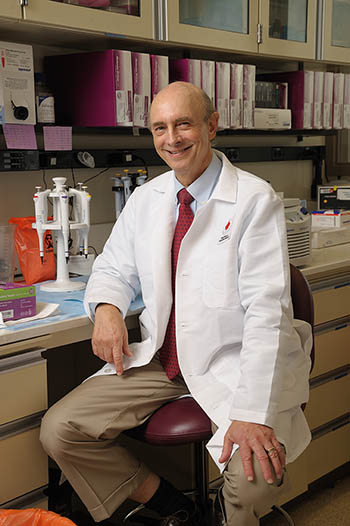From the Deputy Director for Intramural Research
A Wonderful October Surprise for the NIH
Harvey Alter Wins the Nobel Prize

Unless you have been on Mars, which incidentally is closer to Earth than it will be for next 15 years and is easily visible as an orange orb in the southeast sky after sunset, you know that early Monday morning, on October 5, 2020, our own Harvey Alter, senior scientist in the NIH Clinical Center, got a call from Sweden notifying him that he was sharing this year’s Nobel Prize in Medicine or Physiology for his pioneering work on defining and detecting the hepatitis C virus. Although this work had previously been recognized by the Lasker Prize in 2000 and the Canada Gairdner International Award in 2013, the NIH had pretty much given up hope that the Nobel Prize committee would recognize Harvey’s critical contribution to what has since become the potential eradication (through drug treatment) of this virus in infected individuals, and the elimination of a public-health plague.
To be clear, Harvey’s work had directly made it possible to cleanse the blood supply of the agents that caused hepatitis (both B and C agents) through blood transfusions. His work was instrumental in leading to the development of new diagnostic and therapeutic agents and providing the scientific basis for instituting blood-donor screening programs that have decreased the incidence of transfusion-transmitted hepatitis to near zero.

CREDIT: ERNIE BRANSON
Harvey Alter shared the 2020 Nobel Prize in Medicine or Physiology for the “discovery of hepatitis C virus.”
But hepatitis C could still be transmitted in other ways such as shared needles among intravenous-drug users. One continuing consequence of hepatitis C infection is cirrhosis of the liver and the eventual development of liver cancer in a high percentage of chronically infected individuals. So treatment of all infected patients has become a goal of public-health experts. Harvey continues to study the natural history and outcomes of hepatitis C infection and is collaborating with Marc Ghany and others in the Liver Diseases Branch (in the National Institute of Diabetes and Digestive and Kidney Diseases) to conduct long-term follow-up studies of patients to see if cirrhosis is prevented or goes away post treatment.
There is probably no one at NIH whose work has had more impact on improving the public health, and so it seems appropriate to ask how this work came to be in the intramural research program (IRP). How did Harvey himself come to be in the IRP? Like many “Yellow Berets” (including myself), he was invited by the federal government in the 1960s to report for military duty. We sought instead to provide service to our country by working at NIH; Harvey chose to work at the NIH Clinical Center. (The term “Yellow Beret” came about because those who came to NIH to fulfill the two-year selective service obligation for every male physician—or, as some said, to avoid the draft—were initially perceived as cowards, the opposite of the brave U.S. Army Special Forces called the Green Berets. Later, however, most considered “Yellow Beret” to be a badge of pride.)
Harvey’s choice precipitated a series of events that clarify why the IRP continues to be the source of innovative and high-impact scientific discoveries. Consider how the IRP:
- Provides opportunities to collaborate with world-class scientists: Trained as a hematologist, Harvey began to work in the NIH Clinical Center Blood Bank and became interested in detecting antigens in blood (using a standard technique) that might contribute to transfusion reactions. This work was stimulated by a long-term collaboration with Baruch Blumberg. Harvey and Baruch discovered the Australia Antigen, which turned out to be the hepatitis B antigen. Baruch Blumberg received the Nobel Prize for this work.
- Offers researchers the ability to do long-term studies that are hypothesis-generating: Harvey has commented about how the NIH IRP enabled him to collect and store longitudinal samples from cardiac-surgery patients, who had about a 30% incidence of hepatitis related to the clinically required transfusions, and pursue his research interests over many years without having to write grants. It soon became clear that only 25% of post-transfusion hepatitis was due to hepatitis B and none due to hepatitis A virus. Hence, the vast majority of cases were due to a new infectious entity that the research team cautiously called non-A, non-B hepatitis. Harvey, Bob Purcell, Steve Feinstone, and Patrizia Farci set out to discover the missing agent. Harvey says he doubts that these studies could have been done anywhere other than NIH. Only the intramural program would have supported his large blood repository and his chimpanzee studies, both of which proved critical to the discovery of hepatitis C, or funded the “nondirected” research when it wasn’t clear where the research was going. The actual cloning of the hepatitis C viral genome was accomplished by a group led by Michael Houghton at Chiron (with whom this year’s Nobel Prize was shared along with NIH-supported researcher Charles Rice at Rockefeller University in New York). But Harvey’s pioneering work defining the existence of this virus and his establishment of a repository of coded blood samples that included non-A, non-B hepatis proved critical for the discovery.
- Recognizes unusual talent: No one is more self-effacing, more generous, and more able to see the humor in most situations than Harvey. But his pleasant exterior masks a very sharp, persistent, and intuitive intellect that is apparent to all of us who have gotten to know Harvey well. He is a very serious and effective scientist who just happens to be able to laugh at himself and his life’s work and along the way earn the support of his colleagues and supervisors. I like to think that NIH has a good eye for talent. Harvey’s career here illustrates that quality.
- Allows researchers to take advantage of special resources: The NIH Clinical Center is a unique resource. Harvey’s career at NIH reflects the optimal use of this resource, which provides access to an unusual patient population; supports the ability to do studies over several decades; and has the capacity to collect and characterize clinical samples and data from patients.
- Dedicates itself to the public health: At its core, Harvey’s work is about defining an important public-health problem (hepatitis-virus-contaminated blood), doing research to understand the nature of the problem, and applying knowledge to alleviate the public-health consequences. This dedication is written into the mission statement for the NIH and its Clinical Center and underlies much of the work done at the NIH.
So please join me in congratulating Harvey Alter and the NIH for this wonderful recognition of a life’s work dedicated to the public health, and let us redouble our efforts to preserve the environment here that enabled our latest Nobel laureate’s lifesaving work.
There are now six Nobel laureates who did the entirety of their award-winning research at the NIH as federal scientists: Marshall Nirenberg, Julius Axelrod, Christian Anfinsen, D. Carleton Gajdusek, Martin Rodbell, and Harvey Alter. For a complete list of NIH Nobel laureates including those who trained or worked extensively in one of NIH’s intramural laboratories, visit https://irp.nih.gov/about-us/honors/nobel-prize.
This page was last updated on Monday, March 21, 2022
